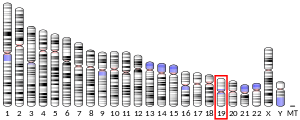Neurocan
Neurocan core protein is a protein that in humans is encoded by the NCAN gene.[5][6]
Neurocan is a member of the lectican / chondroitin sulfate proteoglycan protein families and consists of neurocan core protein and chondroitin sulfate. It is thought to be involved in the modulation of cell adhesion and migration.[6]
Role in bipolar disorder
Neurocan is a significant component of the extracellular matrix, and its levels are modulated by a variety of factors, but mice in which the NCAN gene has been knocked out show no easily observable defects in brain development or behavior.[7] However, a genome-wide association study published in 2011 identified Neurocan as a susceptibility factor for bipolar disorder.[8] A more comprehensive study published in 2012 confirmed that association.[9] The 2012 study examined correlations between NCAN alleles and various symptoms of bipolar disorder, and also examined the behavior of NCAN knockout mice. In the human subjects, it was found that NCAN genotype was strongly associated with manic symptoms but not with depressive symptoms. In the mice, the absence of functional Neurocan resulted in a variety of manic-like behaviors, which could be normalized by administering lithium.
References
- GRCh38: Ensembl release 89: ENSG00000130287 - Ensembl, May 2017
- GRCm38: Ensembl release 89: ENSMUSG00000002341 - Ensembl, May 2017
- "Human PubMed Reference:". National Center for Biotechnology Information, U.S. National Library of Medicine.
- "Mouse PubMed Reference:". National Center for Biotechnology Information, U.S. National Library of Medicine.
- Rauch U, Karthikeyan L, Maurel P, Margolis RU, Margolis RK (Oct 1992). "Cloning and primary structure of neurocan, a developmentally regulated, aggregating chondroitin sulfate proteoglycan of brain". J Biol Chem. 267 (27): 19536–47. PMID 1326557.
- "Entrez Gene: NCAN neurocan".
- Zhou XH, Brakebusch C, Matthies H, Oohashi T, Hirsch E, Moser M, Krug M, Seidenbecher CI, Boeckers TM, Rauch U, Buettner R, Gundelfinger ED, Fässler R (September 2001). "Neurocan is dispensable for brain development". Mol. Cell. Biol. 21 (17): 5970–8. doi:10.1128/MCB.21.17.5970-5978.2001. PMC 87315. PMID 11486035.
- Cichon S, Mühleisen TW, Degenhardt FA, Mattheisen M, Miró X, Strohmaier J, Steffens M, Meesters C, Herms S, Weingarten M, Priebe L, Haenisch B, Alexander M, Vollmer J, Breuer R, Schmäl C, Tessmann P, Moebus S, Wichmann HE, Schreiber S, Müller-Myhsok B, Lucae S, Jamain S, Leboyer M, Bellivier F, Etain B, Henry C, Kahn JP, Heath S, Hamshere M, O'Donovan MC, Owen MJ, Craddock N, Schwarz M, Vedder H, Kammerer-Ciernioch J, Reif A, Sasse J, Bauer M, Hautzinger M, Wright A, Mitchell PB, Schofield PR, Montgomery GW, Medland SE, Gordon SD, Martin NG, Gustafsson O, Andreassen O, Djurovic S, Sigurdsson E, Steinberg S, Stefansson H, Stefansson K, Kapur-Pojskic L, Oruc L, Rivas F, Mayoral F, Chuchalin A, Babadjanova G, Tiganov AS, Pantelejeva G, Abramova LI, Grigoroiu-Serbanescu M, Diaconu CC, Czerski PM, Hauser J, Zimmer A, Lathrop M, Schulze TG, Wienker TF, Schumacher J, Maier W, Propping P, Rietschel M, Nöthen MM (March 2011). "Genome-wide association study identifies genetic variation in neurocan as a susceptibility factor for bipolar disorder". Am. J. Hum. Genet. 88 (3): 372–81. doi:10.1016/j.ajhg.2011.01.017. PMC 3059436. PMID 21353194.
- Miró X, Meier S, Dreisow ML, Frank J, Strohmaier J, Breuer R, Schmäl C, Albayram Ö, Pardo-Olmedilla MT, Mühleisen TW, Degenhardt FA, Mattheisen M, Reinhard I, Bilkei-Gorzo A, Cichon S, Seidenbecher C, Rietschel M, Nöthen MM, Zimmer A (September 2012). "Studies in humans and mice implicate neurocan in the etiology of mania". Am J Psychiatry. 169 (9): 982–90. doi:10.1176/appi.ajp.2012.11101585. PMID 22952076.
Further reading
- Rauch U, Grimpe B, Kulbe G, Arnold-Ammer I, Beier DR, Fässler R (1996). "Structure and chromosomal localization of the mouse neurocan gene". Genomics. 28 (3): 405–10. doi:10.1006/geno.1995.1168. PMID 7490074.
- Friedlander DR, Milev P, Karthikeyan L, Margolis RK, Margolis RU, Grumet M (1994). "The neuronal chondroitin sulfate proteoglycan neurocan binds to the neural cell adhesion molecules Ng-CAM/L1/NILE and N-CAM, and inhibits neuronal adhesion and neurite outgrowth". J. Cell Biol. 125 (3): 669–80. doi:10.1083/jcb.125.3.669. PMC 2119998. PMID 7513709.
- Milev P, Maurel P, Häring M, Margolis RK, Margolis RU (1996). "TAG-1/axonin-1 is a high-affinity ligand of neurocan, phosphacan/protein-tyrosine phosphatase-zeta/beta, and N-CAM". J. Biol. Chem. 271 (26): 15716–23. doi:10.1074/jbc.271.26.15716. PMID 8663515.
- Retzler C, Göhring W, Rauch U (1996). "Analysis of neurocan structures interacting with the neural cell adhesion molecule N-CAM". J. Biol. Chem. 271 (44): 27304–10. doi:10.1074/jbc.271.44.27304. PMID 8910306.
- Rauch U, Clement A, Retzler C, Fröhlich L, Fässler R, Göhring W, Faissner A (1997). "Mapping of a defined neurocan binding site to distinct domains of tenascin-C". J. Biol. Chem. 272 (43): 26905–12. doi:10.1074/jbc.272.43.26905. PMID 9341124.
- Milev P, Chiba A, Häring M, Rauvala H, Schachner M, Ranscht B, Margolis RK, Margolis RU (1998). "High affinity binding and overlapping localization of neurocan and phosphacan/protein-tyrosine phosphatase-zeta/beta with tenascin-R, amphoterin, and the heparin-binding growth-associated molecule". J. Biol. Chem. 273 (12): 6998–7005. doi:10.1074/jbc.273.12.6998. PMID 9507007.
- Prange CK, Pennacchio LA, Lieuallen K, Fan W, Lennon GG (1998). "Characterization of the human neurocan gene, CSPG3". Gene. 221 (2): 199–205. doi:10.1016/S0378-1119(98)00455-7. PMID 9795216.
- Oleszewski M, Gutwein P, von der Lieth W, Rauch U, Altevogt P (2000). "Characterization of the L1-neurocan-binding site. Implications for L1-L1 homophilic binding". J. Biol. Chem. 275 (44): 34478–85. doi:10.1074/jbc.M004147200. PMID 10934197.
- Hartley JL, Temple GF, Brasch MA (2001). "DNA cloning using in vitro site-specific recombination". Genome Res. 10 (11): 1788–95. doi:10.1101/gr.143000. PMC 310948. PMID 11076863.
- Brandenberger R, Wei H, Zhang S, Lei S, Murage J, Fisk GJ, Li Y, Xu C, Fang R, Guegler K, Rao MS, Mandalam R, Lebkowski J, Stanton LW (2005). "Transcriptome characterization elucidates signaling networks that control human ES cell growth and differentiation". Nat. Biotechnol. 22 (6): 707–16. doi:10.1038/nbt971. PMID 15146197.



